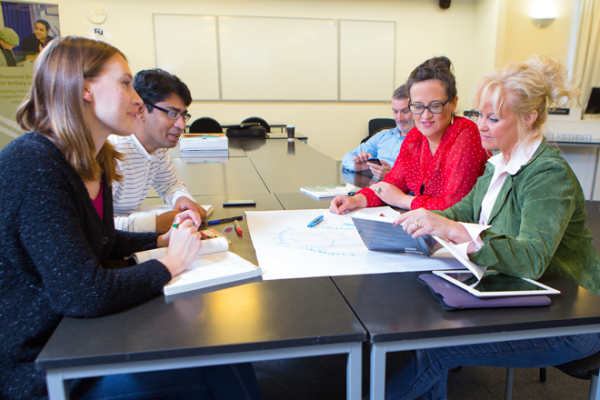Getting creative with AI in the classroom
This page is for educators ready to take the next step — trying out AI in real teaching contexts, without losing sight of learner voice, equity, or integrity.
 This is guide 2 in a 6-part series from Ako Aotearoa, designed to help educators explore AI in education — safely, ethically, and in ways that reflect our values in Aotearoa New Zealand.
This is guide 2 in a 6-part series from Ako Aotearoa, designed to help educators explore AI in education — safely, ethically, and in ways that reflect our values in Aotearoa New Zealand.
Each guide offers practical steps, real examples, and reflective tools to support your journey. Whether you’re just starting or deepening your practice, these resources are here to support you.
Explore practical, creative, and safe ways to integrate AI tools into your teaching.
Start Small — Where AI Can Add Value
You don’t have to go all in. Try one thing at a time.
|
Planning: |
Generate quiz questions, brainstorm session outlines |
|
Admin: |
Draft feedback, condense learning outcomes |
|
Content: |
Rephrase complex ideas, simplify texts, visualise processes |
|
Educator Insight: |
Prompt Ideas:
- “Give me five reflection questions about teamwork for hospitality students.”
- “Simplify this explanation of osmosis for a Level 3 learner.”
- “Turn these bullet points into a short paragraph about safe lifting.”
Start in low-risk areas where mistakes don’t carry big consequences. |
AI-Enhanced teaching ideas
Try These in Class
|
Teaching Activity |
AI Use Example |
|
Brainstorming |
“List 10 ideas for engaging learners in a budgeting topic” |
|
Summarising |
“Summarise this 2-page article in 5 bullet points” |
|
Rewriting |
“Make this feedback sound more encouraging” |
|
Compare + Critique |
“Give me two versions of an introduction to critique” |
|
Vocabulary Builder |
“What are simpler synonyms for these words?” |
|
Visual Learning |
Use DALL·E to visualise abstract concepts |
|
Educator Tip:
Ask: “What’s missing?” or “What would you change?” |
Student-Facing Use — With Integrity
Scaffold Their Use
- Make AI use visible, not secret
- Ask students to highlight or annotate what AI helped them with
- Use prompts that require editing, reflecting, or comparing
Suggested Learner Prompts:
- “Ask ChatGPT to create a sample response — now rewrite it using your own words.”
- “Use AI to summarise this article, then compare it with your version.”
Design Tasks with Voice and Value
|
Instead of... |
Try... |
|
Standard essay |
AI-generated draft + student critique/reflection |
|
Reading summary |
Compare your summary with an AI one |
|
Memorise and repeat definitions |
Explain the concept in your own context or industry |
|
Focus on tasks that blend AI use with personalisation, reasoning, or reflection. |
Resources to explore and use
Quick-Start Tools
Useful Reading
Videos + Walkthroughs
- Sal Khan – How to Prompt Khanmigo (AI for Education)
- EDUCAUSE – Striking a Balance: Navigating the Ethical Dilemmas of AI in Higher Education
 Want to go deeper?
Want to go deeper?
- Jisc – AI Maturity Toolkit for Tertiary Education
- OpenAI Educator FAQ
- AI for Learning Designers – ASCILITE Resource
Printable resource references
Full link list for print readers:
- OpenAI. (2025). ChatGPT.https://chat.openai.com
- Poe. (2025). Multi-Model AI Chat Tool. https://poe.com
- OpenAI. (2024). DALL·E Image Generator. https://openai.com/dall-e
- Ako Aotearoa. (2024). AI + Assessment Redesign. https://info.ako.ac.nz/ako-aotearoa-blog/rethinking-assessment-what-ai-means-for-tertiary-education
- Liu, D. (2024). AI in the Classroom. University of Sydney. https://canvas.sydney.edu.au/courses/63765
- EDUCAUSE. (2024, December). Striking a balance: Navigating the ethical dilemmas of AI in higher education. EDUCAUSE Review. https://er.educause.edu/articles/2024/12/striking-a-balance-navigating-the-ethical-dilemmas-of-ai-in-higher-education
- Jisc. (2023). AI maturity toolkit for tertiary education. https://www.jisc.ac.uk/ai-maturity-toolkit-for-tertiary-education
- OpenAI. (2024). Educator FAQ: Teaching with AI tools like ChatGPT. https://help.openai.com/en/collections/5929286-educator-faq
- Bennett, S., West, D., & Mackey, J. (2024). Co-designing an AI literacies framework for learning designers. In Australasian Society for Computers in Learning in Tertiary Education (ASCILITE). https://publications.ascilite.org/index.php/APUB/article/view/1136
Try this with AIHOA
“How can I scaffold student use of ChatGPT ethically?” “What’s a good AI-supported reflection task for project-based learning?”
Chat with AIHOA – Opens in ChatGPT AIHOA runs on ChatGPT by OpenAI. A free ChatGPT account is required. You can create one when you first open the chat. Free accounts include a limited number of interactions per day. Subscriptions offer extended access. |
Where to next?
Key ideas – AI and assessment integrity | Go back to Practical tips



